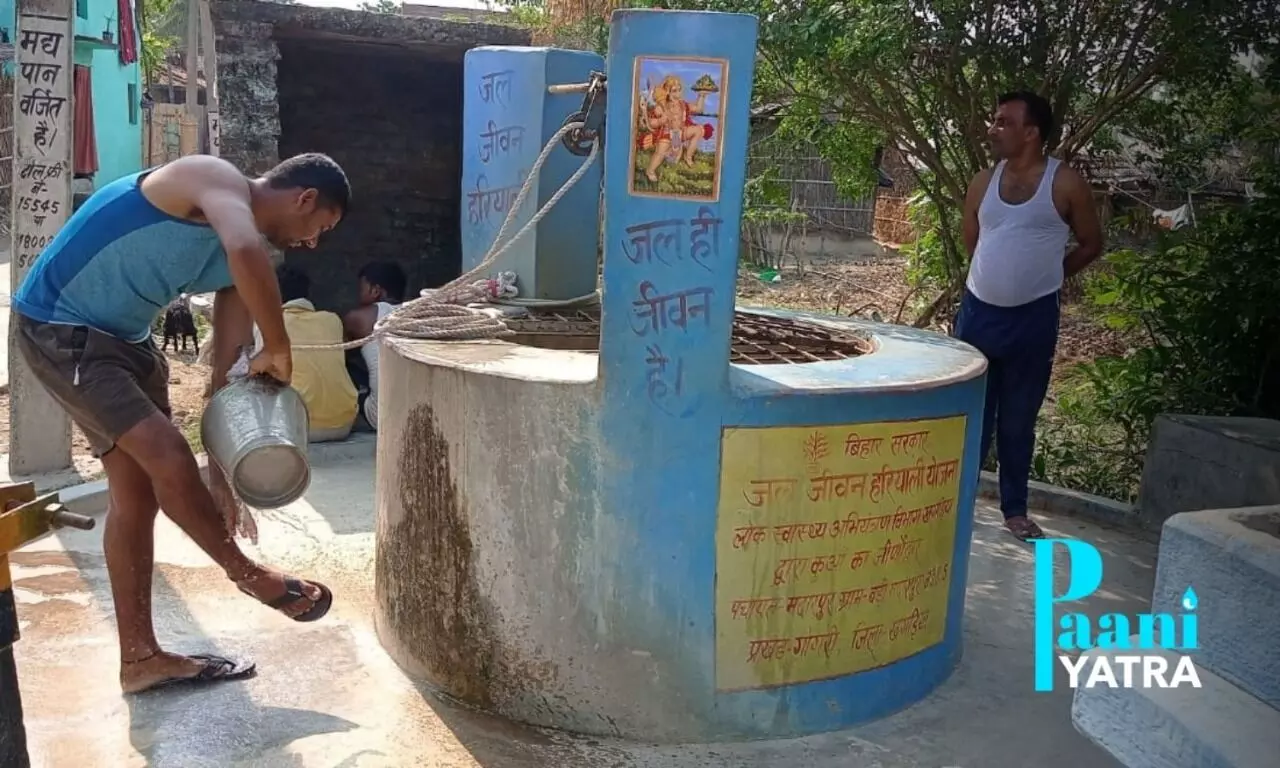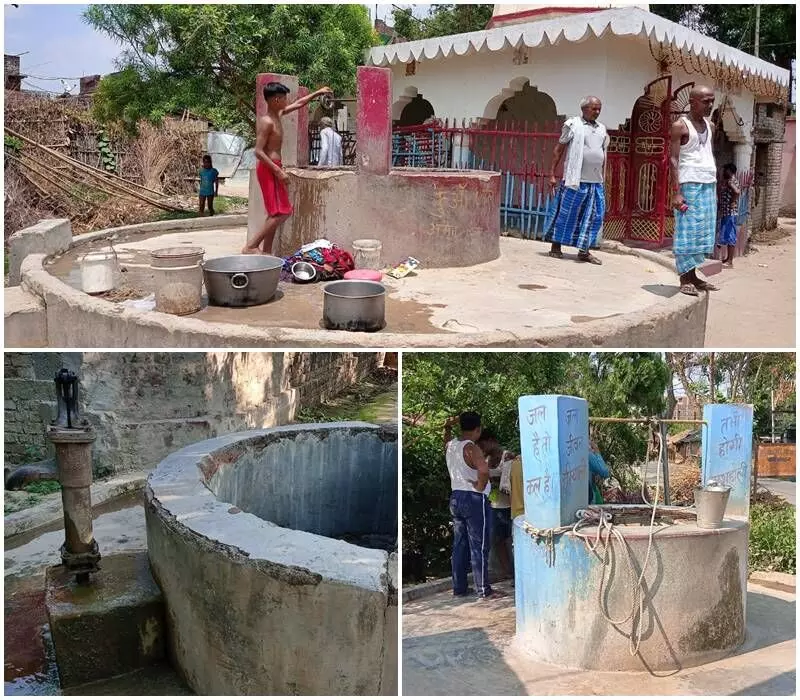Madarpur (Khagaria), Bihar
Manusatyam Rai, a 72-year-old resident of Madarpur in Bihar’s Khagaria district claims that the cases of cancer are on a decline in his village ever since the villagers renounced using handpumps for their potable water needs and switched to using water from the dugwells.
“Between 2000-2010, more than 25 people died of cancer and stomach-related diseases in our village. Most of them had liver cancer which doctors said was due to drinking toxic water,” he told Gaon Connection. But, once the village inhabitants switched to fetching water from wells rather than depending on the handpumps, the cases have come down, the 72-year-old said.
The population of Madarpur village is about 6,000. According to Rai, the villagers were drinking water from the handpump till 2011. There are a total of four wells in the Madarpur village and three of them are used for the village’ potable water needs while the fourth well is yet to be revived.
Watch Also
Also Read: A Midsummer Pipe Dream: Pipelines laid down and taps installed, but where is the water?
When Gaon Connection contacted the nearest health centre from the village, it was learnt that the Madarpur has reported a decline in the number of cases of diseases caused by the consumption of water laden with toxins.
“The cases of liver infections which are caused by drinking water laden with toxins are on a rise in the Khagaria district. Same is true for the Gogri block [in which Madarpur is situated] but it is observed that there is a sharp decline in the cases of such diseases in Madarpur village and some other villages in the areas around Madarpur,” Arvind Kumar Sinha, a doctor appointed at the Referral Hospital at the Gogri block headquarters which is situated about 25 kilometres from the Madarpur village, told Gaon Connection.

The demos along with the fact that there was a marked decline in the cases of cancer over the last few years convinced the villagers like nothing else that it was safer to renounce the use of the handpump for drinking purposes altogether. Photo by Rahul Tiwari
Apart from Madarpur, the rural residents in neighbouring villages of Maheshkhunt and Chhoti Madarpur were also found to be using water from the dugwells for their potable water usage.
“A vast majority of the villagers in our village use wells for drinking water. Ever since we began using water from the wells about ten years back, we have observed that the stomach ailments are far less prevalent now,” Rahul Kumar, a resident of Neerpur village which is situated about three kilometres from Madarpur, told Gaon Connection.
Between 2009-2011, Megh Pyne Abhiyan, a public charitable trust that works on the issue of water crisis in the states of Bihar, Jharkhand and West Bengal, demonstrated to the rural residents of Khagaria the difference in quality of water taken from a handpump and a well. The high presence of iron in the water from the handpumps had a corrosive effect on the grinded guava leaves while the water drawn from the wells kept the leaves unaffected.
The demos along with the fact that there was a marked decline in the cases of cancer over the last few years convinced the villagers like nothing else that it was safer to renounce the use of the handpump for drinking purposes altogether.

It is important to realise that the high levels of arsenic in the groundwater in Bihar is not because of industrial effluents or pollution but due to over-exploitation of the underground water reserves. Photo by Rahul Tiwari
Between 2009-2011, the Megh Pyne Abhiyan assisted the local residents in the districts of Supaul, Saharsa, Khagaria, Madhubani and West Champaran in reviving a total of 64 dugwells while it helped in the repairs of 41 such wells.
Amarlata Devi, a 50-year-old resident, remembers these efforts made almost a decade ago which helped her village switch from handpumps to wells for their drinking water needs.
“Some samaajik kaaryakarta (NGO workers) visited our village about ten years back. They showed us the effect of the toxic water from the handpumps which harmed amrood (guava) leaves. And, this was the very water that we drank. They helped us in reviving our old broken wells too,” Amarlata Devi said.
When Gaon Connection contacted the Mission Director of the Jal-Jeevan-Hariyali Mission to enquire about the data about the status of the wells in the state, it was learnt that a total of 13,630 public wells have been identified as encroached, out of which encroachment has been removed from 5,490 wells and the efforts to remove encroachment on the remaining wells are underway.
“A total of 30,425 public wells have been taken up for renovation under the campaign, out of which 18,170 have been renovated and remaining is under process. Under the campaign, construction of soak pits near all the public wells have been taken up. Against the target of 18,760, a total of 12,871 soak pits have been constructed near the public wells and remaining is under process,” Rahul Kumar, Mission Director of the Jal Jeevan Hariyali Mission told Gaon Connection.

Between 2009-2011, the Megh Pyne Abhiyan assisted the local residents in the districts of Supaul, Saharsa, Khagaria, Madhubani and West Champaran in reviving a total of 64 dugwells while it helped in the repairs of 41 such wells.
Back to roots, backed by science
“There’s this belief amongst the villagers that paani todna or agitating the water in a well by throwing a bucket into it, ensures clean water,but there is a scientific reason for it too,” Eklavya Prasad, founder of the Megh Pyne Abhiyan, told Gaon Connection.
The water drawn from the bucket is clean. Stirring or agitation of water by a bucket triggers aeration (mixing of air with water) which results in oxidation of the elements like iron and arsenic, he explained.

There are a total of four wells in the Madarpur village and three of them are used for the village’ potable water needs while the fourth well is yet to be revived. Photos by Rahul Tiwari
The oxidation results in the elements settling down at the bottom of the well.
“Stirring or agitation of the water by the bucket, causes the iron to change from its soluble to insoluble form which precipitates. Similarly, the soluble arsenic changes to its insoluble state and collects at the bottom of the well,” the expert added.
In a hand pump on the other hand, oxidation rarely happens because of its enclosed design. An official at the Public Health Division in Khagaria district, said that well water is free from arsenic which is known to cause cancer.

“Wells are the best source of clean water in rural areas. Its water is found to be free from damaging levels of arsenic. It is because of this that many water experts are raising awareness campaigns to encourage the use of water from the wells,” Sanjay Pandey, chemical scientist at the Public Health Division told Gaon Connection.
Also, Rajendra Kumar, an engineer in the state government’s Water Resources Department said that research conducted by the government has not found the presence of arsenic or high levels or iron in the water from the wells.
“It is important to realise that the high levels of arsenic in the groundwater in Bihar is not because of industrial effluents or pollution but due to over-exploitation of the underground water reserves,” Rajendra Kumar told Gaon Connection. Wells ensure that the water is not overexploited or wasted. The water in the well is exposed to sunlight which purifies the water, he added.
‘Taps all around but no water to drink’
Meanwhile, Ram Kali Devi, a resident of the Madarpur village complained about the government’s initiative to ensure tap water connections in rural households.
“What is the point of installing taps when there’s no water coming out of it? The handpumps were also giving out unhealthy water and these are useless during floods. The villagers themselves repaired and revived wells for our water needs when government initiatives like providing tap water failed,” the 50-year-old told Gaon Connection.
She added that there is no redressal of the complaints raised about dysfunctional taps.

In Bihar, 92.72 per cent of rural households have tap water supply.
“The government has merely installed taps and tanks but no official ever checks if these arrangements are working or not. There is no regard for repairing the taps and all our complaints fall on deaf ears. Government’s efforts to install taps in rural households are not helping. It will be far better if the government revives old wells and ensures their regular maintenance,” Ram Kali Devi said.
Interestingly, as per the data on the dashboard of the Jal Jeevan Mission, 92.72 per cent of rural households have tap water supply. The central government’s tap water scheme aims to provide tap water connections to all rural households in the country by 2024.
Groundwater contamination crisis in Bihar
As per the state government’s yearly pre-budget report, Bihar Economic Survey 2021-22, out of the 38 districts in the state, groundwater in 29 is contaminated by either arsenic, fluoride, or iron. Water and sanitation in 56,544 rural wards out of the total 114,691 rural wards fall under the ambit of the state’s Public Health Engineering Department.
“Of these wards, drinking water in 30,272 wards come under quality-affected areas and 26,272 under non-quality affected areas. Currently, drinking water in 4742 wards contain arsenic, 3791 contain fluoride and 21,739 contain high levels of iron. Of these, work has been completed in 4238 arsenic-affected, 3763 fluoride-affected and 20,996 iron-affected wards (Table 8.17),” the report mentioned.
To make matters worse, a joint research conducted by Patna-based Mahavir Cancer Institute and Research Centre and The University of Manchester found high levels of uranium in the groundwater of at least ten districts in the state.

As per the state government’s yearly pre-budget report, Bihar Economic Survey 2021-22, out of the 38 districts in the state, groundwater in 29 is contaminated by either arsenic, fluoride, or iron.
The research study titled Distribution and Geochemical Controls of Arsenic and Uranium in Groundwater-Derived Drinking Water in Bihar, India was published in the International Journal of Environmental Research and Public Health on April 6, 2020. As per the study, Supaul, Gopalganj, Siwan, Saran, Patna, Nalanda, Nawada, Aurangabad, Gaya and Jehanabad are the 10 districts in Bihar where high levels of uranium were found in the groundwater.
Taking cognizance of the economic survey report, the National Human Rights Commission [NHRC] stated on March 4, 2022 that the contamination ‘may be causing serious health hazards including, among others, liver and kidney related problems’.
“…Accordingly, it [NHRC] has issued notices to the Chief Secretary and Secretary, Public Health Engineering Department, Govt. of Bihar calling for a report within six weeks. It should include safety measures taken to provide potable water in those districts and also the implementation of the scheme under “Har-Ghar-Jal-Nal-Yojana”. The Commission has also asked the State Pollution Control Board to submit the report on the random sampling of groundwater,” the human rights body mentioned.




















